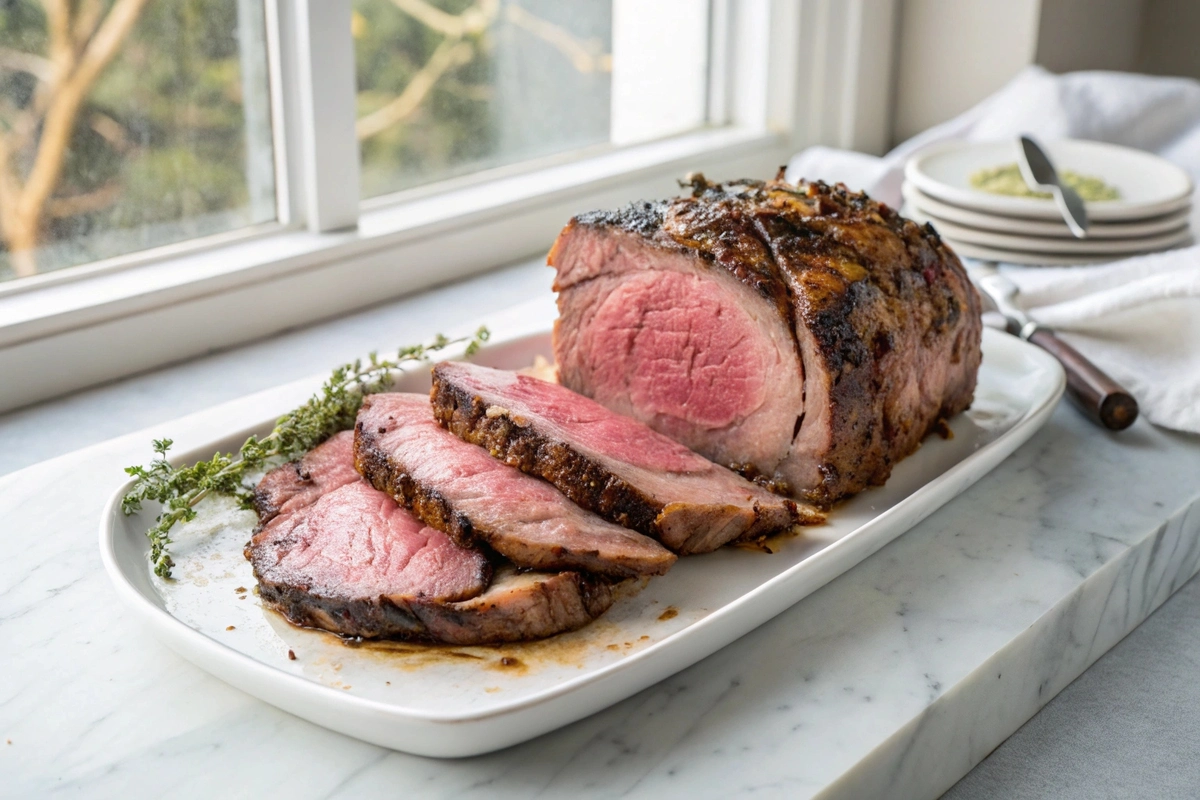A foolproof, restaurant-quality ribeye roast with a crispy crust and tender, juicy center.
There’s nothing quite like a perfectly cooked ribeye roast—richly marbled, packed with flavor, and incredibly tender. If you’ve ever struggled with getting a ribeye roast recipe just right—worrying about overcooking or losing its natural juiciness—you’re in the right place!
I once thought only steakhouses could nail the perfect ribeye roast recipe, but after testing different methods (and picking up a few game-changing tricks), I discovered a fail-proof roasting technique. Whether you’re preparing it for a special occasion or a cozy family dinner, this ribeye roast recipe guarantees restaurant-quality results with minimal effort.
In this guide, you’ll learn:
- The best seasoning mix for a bold, savory flavor.
- The right roasting temperatures for perfect doneness.
- Pro chef tips to keep your roast tender and juicy.
Ready to master the art of ribeye roasting? Let’s get started!
Not sure how to choose the best cut? Check out this expert guide on selecting the perfect ribeye roast to ensure you get the most flavorful and tender meat.
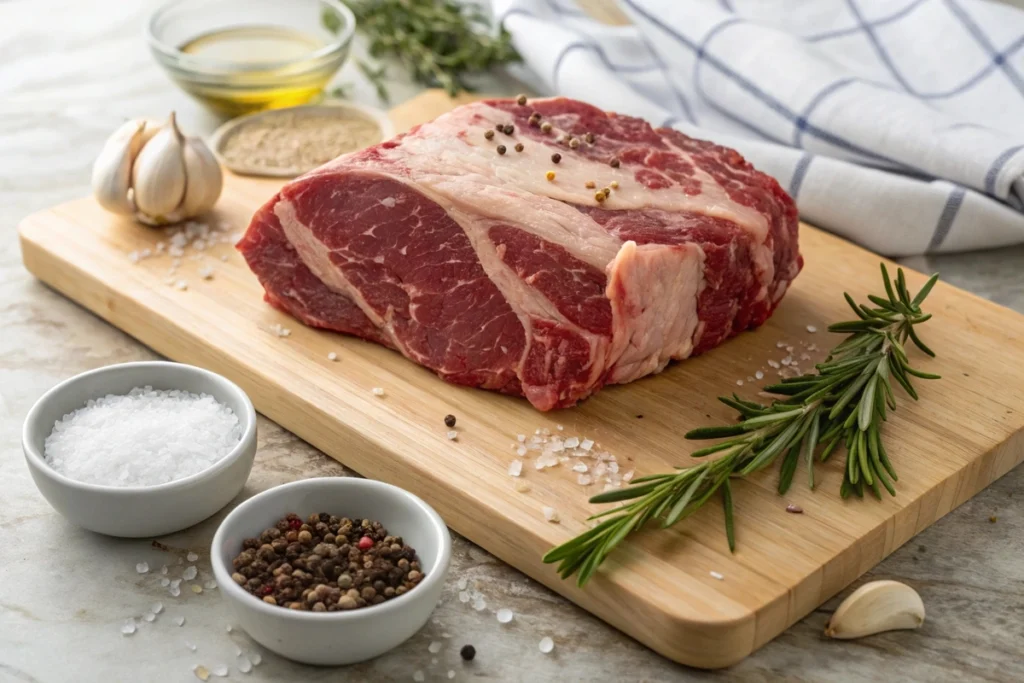
Ingredient Breakdown
A great ribeye roast recipe starts with high-quality ingredients. Here’s what you’ll need to create a perfectly seasoned, juicy roast.
Main Ingredients
- 1 (5-pound) ribeye roast – Choose a well-marbled cut for the best flavor and tenderness. Boneless or bone-in both work.
- 3 tablespoons unsalted butter, softened – Helps create a crisp, golden crust.
- 2 tablespoons olive oil – Aids in even browning and adds richness.
- 3 cloves garlic, minced – Boosts the beef’s natural umami flavor.
- 2 teaspoons kosher salt – Enhances flavor without making the roast too salty.
- 1 teaspoon freshly ground black pepper – Adds a hint of spice and depth.
- 1 teaspoon fresh rosemary, finely chopped – Brings an earthy, herbaceous note.
- 1 teaspoon fresh thyme, finely chopped – Complements the rosemary with a mild, lemony touch.
Optional Flavor Enhancers
- 1 teaspoon Dijon mustard – Creates an extra-savory crust.
- ½ teaspoon smoked paprika – Adds subtle smokiness.
- 1 teaspoon horseradish – Pairs well with beef for a bit of heat.
For Serving
- Horseradish sauce or au jus – Classic condiments for extra richness.
- Fresh parsley, chopped – Adds color and a fresh contrast to the richness of the meat.
Step-by-Step Instructions
Cooking a ribeye roast might seem intimidating, but with this method, you’ll get perfect results every time.
Step 1: Prep the Ribeye Roast
- Bring the roast to room temperature – Remove the ribeye from the fridge at least 1 hour before cooking. This helps it cook evenly.
- Pat dry with paper towels – Removing excess moisture ensures a better sear.
- Season generously – In a small bowl, mix butter, olive oil, garlic, salt, pepper, rosemary, and thyme. Spread the mixture evenly over the roast.
Step 2: Sear for a Golden Crust
- Preheat your oven to 450°F (232°C). While it heats, place the roast in a roasting pan with the fat side up.
- Roast at high heat for 15 minutes – This quick sear locks in juices and creates a flavorful crust.
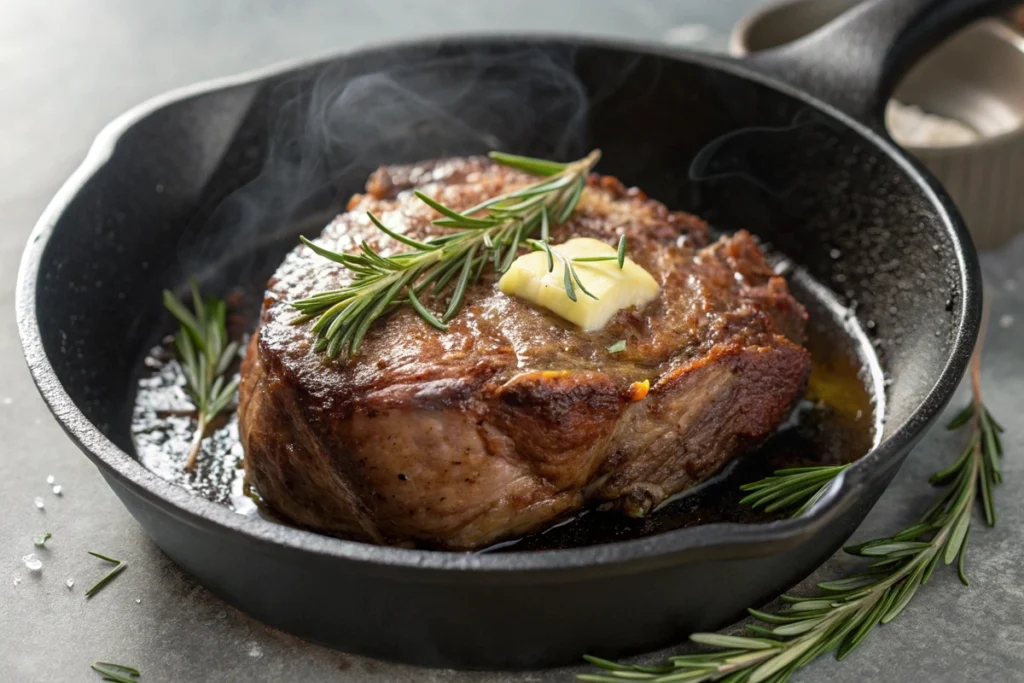
Step 3: Slow Roast to Perfection
- Reduce oven temperature to 325°F (163°C). Continue roasting until the internal temperature reaches:
- 110°F (43°C) for rare
- 120°F (49°C) for medium-rare
- 130°F (54°C) for medium
- 140°F+ (60°C+) for well done
- Use a meat thermometer – Always check the thickest part of the roast for accuracy.
Step 4: Rest Before Carving
- Remove from oven 10°F before your target temperature – The roast will continue cooking as it rests.
- Tent loosely with foil and let it rest for at least 30 minutes. This keeps it juicy.
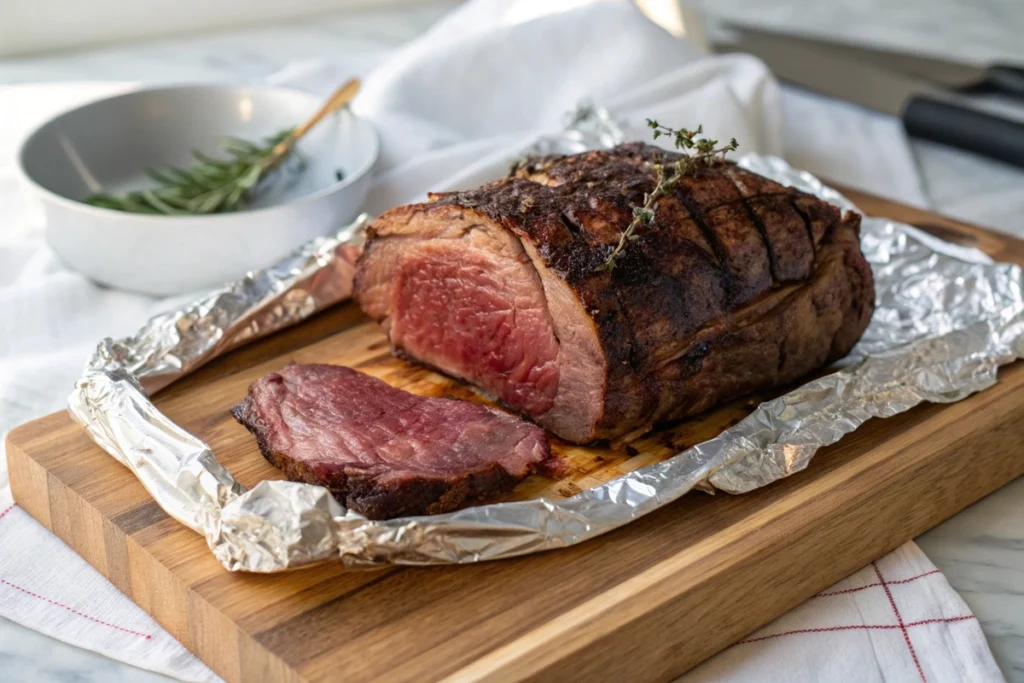
Step 5: Carve & Serve
- Slice against the grain – Use a sharp knife to cut thick, even slices.
- Serve with your favorite sides – Mashed potatoes, roasted vegetables, or a fresh salad pair beautifully.
And that’s it! A foolproof method for a tender, flavorful ribeye roast.
Searing is key to locking in flavor. If you want to learn more about the science behind it, this detailed roasting technique guide explains why high-heat searing makes such a difference
Expert Tips for Carving & Storing Ribeye Roast
Carving a ribeye roast correctly is just as important as cooking it perfectly. The way you slice your roast affects the texture, tenderness, and overall eating experience. Follow these expert carving techniques to get the most out of your roast.
How to Properly Carve a Ribeye Roast
- Use a sharp carving knife – A long, serrated, or straight-edged knife works best. Avoid using a dull blade, which can tear the meat.
- Slice against the grain – This shortens the muscle fibers, making each bite more tender and easier to chew.
- Keep slices even – Aim for ½-inch thick slices for the perfect balance of tenderness and texture.
- Remove excess fat if desired – While the fat enhances flavor, trimming excess outer fat after roasting can create a more refined presentation.
Best Way to Store Leftovers
If you have leftovers, proper storage keeps the meat juicy and flavorful for future meals. Here’s how:
- Refrigeration: Store sliced ribeye roast in an airtight container with a bit of its natural juices to keep it moist. Best enjoyed within 3–4 days.
- Freezing: Wrap slices tightly in plastic wrap and foil, then place them in a freezer bag. Best used within 3 months.
- Reheating: Warm the roast slowly in a 300°F oven, covered with foil, to prevent it from drying out. Avoid microwaving, as it can make the meat tough.
Pro Tip: If you plan to use leftovers for sandwiches, slice the meat thinner before storing for easy reheating and serving!
Nutrition Facts
A ribeye roast is a protein-packed, nutrient-rich dish perfect for special occasions. While indulgent, it fits well into low-carb and keto diets when served with the right sides. Here’s the estimated nutritional breakdown per 6-ounce serving:
Dietary Notes
- Keto-Friendly: High in healthy fats and protein, making it ideal for low-carb diets.
- Gluten-Free: Naturally free from gluten—just be mindful of added sauces.
- Paleo-Friendly: If using olive oil instead of butter, this recipe aligns with paleo guidelines.
- Low-Sodium Adaptation: Reduce salt and use salt-free herb blends to cut sodium content.
Pro Tips / Variations
Cooking a ribeye roast recipe is straightforward, but a few expert tips can make a big difference. Follow these suggestions to ensure perfect results every time.
Common Mistakes to Avoid
- Skipping the resting period – Cutting too soon causes the juices to run out, leaving dry meat.
- Underseasoning – The roast is thick, so be generous with seasoning for flavor throughout.
- Not using a meat thermometer – Guessing leads to overcooking or undercooking. Always check the internal temperature.
Pro Hacks for Busy Cooks
- Pre-season the night before – This allows the flavors to penetrate the meat.
- Use a roasting rack – Elevating the roast ensures even heat circulation.
- Try the reverse-sear method – Instead of high heat first, cook low and slow, then finish at 450°F for an ultra-crispy crust.
Flavor Variations
Want to switch things up? Try these flavor twists:
- Garlic-Herb Crust: Add extra minced garlic, rosemary, and thyme for a classic steakhouse flavor.
- Spicy Cajun Rub: Swap herbs for Cajun seasoning and a touch of cayenne.
- Balsamic Glaze: Brush with balsamic vinegar and brown sugar before roasting for a subtle sweetness.
- Coffee Crust: Mix finely ground coffee with salt and pepper for a bold, smoky profile.
Want a flavorful sauce to accompany your roast? A creamy, tangy dressing can elevate any dish. Try our Bang Bang Sauce Recipe for a spicy, slightly sweet kick that complements roasted meats.
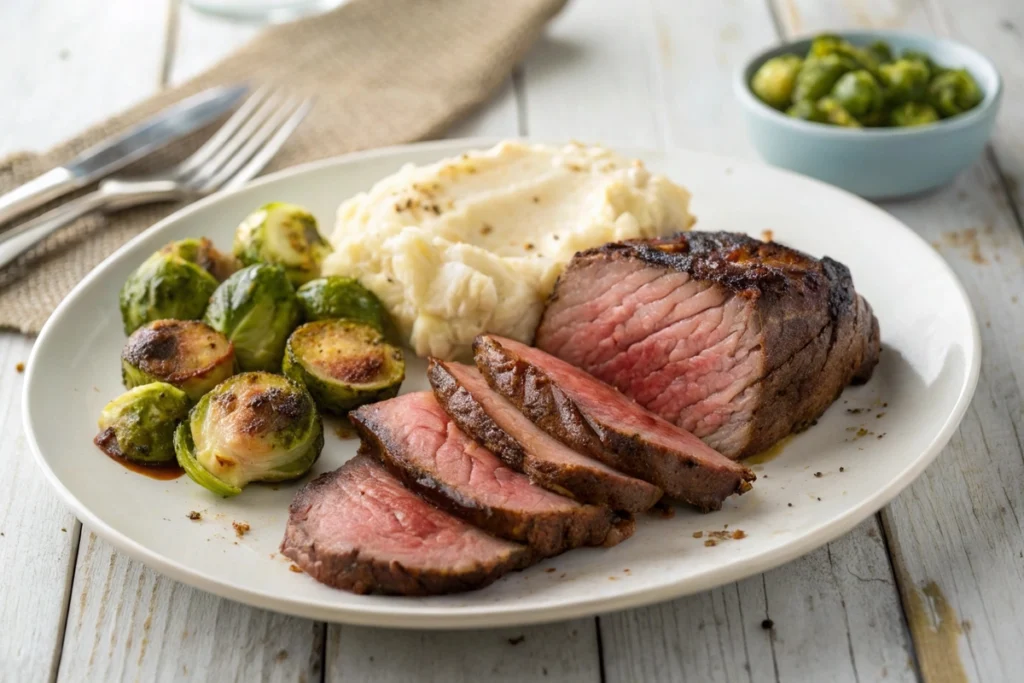
Serving Suggestions & Pairings
A ribeye roast pairs beautifully with classic comfort sides or light, refreshing dishes. Here’s what works best:
Best Side Dishes
- Creamy Mashed Potatoes – The rich, buttery texture complements the beef’s deep flavor.
- Roasted Brussels Sprouts with Bacon – A smoky, crispy contrast to the juicy meat.
- Garlic Butter Green Beans – Adds a light, fresh touch to balance the meal.
- Homemade Dinner Rolls – Perfect for soaking up juices and sauces.
Sauces & Condiments
- Au Jus: A simple, flavorful beef-based dipping sauce.
- Horseradish Cream Sauce: Adds a bold, tangy kick that complements the richness.
- Red Wine Reduction: A luxurious sauce that enhances the depth of flavor.
Leftover Ideas
If you have leftovers, don’t let them go to waste! Try:
- Ribeye Sandwiches – Thinly sliced beef on a toasted roll with horseradish sauce.
- Steak & Egg Breakfast – Serve with scrambled or fried eggs for a hearty morning meal.
- Beef & Veggie Stir-Fry – Quick, easy, and packed with protein.
With these pairing ideas and pro tips, your ribeye roast recipe will be an unforgettable meal from start to finish.
For a well-rounded meal, pair this ribeye roast with classic sides like mashed potatoes or roasted vegetables. If you’re looking for a unique twist, try our Kidney Beans & Squash Side Dish Recipe for a hearty and nutritious option.
Best Drinks to Pair with Ribeye Roast
A well-cooked ribeye roast deserves a perfect drink pairing to enhance its rich flavors. Whether you prefer refreshing juices, teas, or other non-alcoholic beverages, here are some of the best options to complement your meal.
Best Non-Alcoholic Beverages for Ribeye Roast
- Pomegranate Juice Spritzer – A tart and slightly sweet option that enhances the beef’s natural flavors.
- Freshly Brewed Mint Tea – A soothing and aromatic drink that aids digestion while balancing the richness of the meat.
- Blackberry or Grape Juice – Naturally bold and full-bodied, these juices offer a fruit-forward balance to the depth of the ribeye roast.
- Sparkling Citrus Water – A light, bubbly drink that cleanses the palate between bites.
- Cardamom-Spiced Milk – A warm and comforting choice that pairs well with the roast’s deep flavors, especially during colder months.
Pro Tip: Serving a variety of drinks ensures that guests of all preferences can enjoy a perfect pairing with their meal.
Why You’ll Love This Recipe
There’s something special about a ribeye roast recipe that turns an ordinary meal into an unforgettable feast. Whether you’re making it for a holiday dinner or a cozy weekend meal, here’s why you’ll love this dish:
- Fail-Proof Method: The step-by-step approach ensures a perfectly cooked, juicy roast every time.
- Unmatched Flavor: Thanks to its rich marbling, ribeye roast delivers a tender, buttery texture with a deep, beefy taste.
- Beginner-Friendly: No special equipment or culinary expertise is needed—just simple, tried-and-true techniques.
- Versatile Pairings: Pairs beautifully with everything from classic mashed potatoes to fresh, roasted vegetables.
- Great for Special Occasions: It’s a stunning centerpiece for Christmas, Thanksgiving, or any family gathering.
If you’ve been looking for the ultimate ribeye roast recipe, this one delivers a foolproof, restaurant-quality meal without the stress.
FAQ
Is ribeye good for roasting?
Absolutely! Ribeye is one of the best cuts for roasting due to its rich marbling, which keeps the meat tender and flavorful. Unlike leaner cuts, ribeye remains juicy even when slow-roasted, making it an excellent choice for a show-stopping roast.
Is a ribeye roast the same thing as prime rib?
Not exactly. Both come from the same part of the cow, but a prime rib usually includes the bone, while a ribeye roast is boneless. Prime rib is often cooked bone-in for extra flavor, but a boneless ribeye roast is easier to carve while still offering a rich, beefy taste.
What temperature should a ribeye roast be cooked at?
For best results, start at 450°F (232°C) for 15 minutes to create a crispy crust, then lower to 325°F (163°C) until the roast reaches your preferred doneness:
- Rare: 110°F (43°C)
- Medium Rare: 120°F (49°C)
- Medium: 130°F (54°C)
- Well Done: 140°F+ (60°C+)
Always use a meat thermometer for accuracy. The roast will continue cooking after it’s removed from the oven, so take it out 10°F before your target temperature.
Should I sear a ribeye roast before cooking?
Yes! Searing is essential for a deep, flavorful crust. In this recipe, the roast is started at high heat (450°F) for 15 minutes to achieve that perfect golden-brown exterior. This method locks in juices while keeping the inside tender and moist.
Perfecting Your Ribeye Roast for Any Occasion
A ribeye roast recipe doesn’t have to be intimidating. With the right seasoning, proper cooking temperature, and a little patience, you’ll have a tender, juicy, and flavorful roast every time. Whether you’re serving it for a special occasion or just a comforting family dinner, this dish is sure to impress.
Now that you’ve mastered the perfect ribeye roast, it’s time to gather your favorite sides, slice into that beautifully cooked beef, and enjoy a truly unforgettable meal. Happy cooking!

